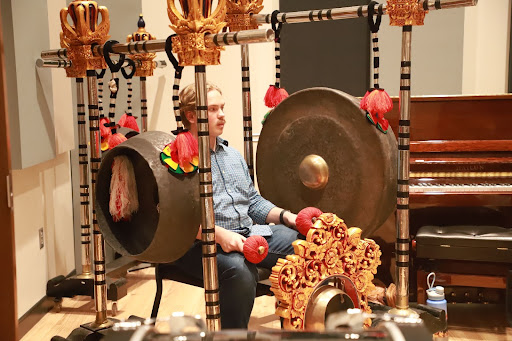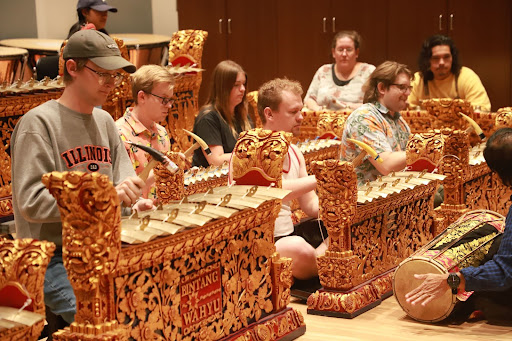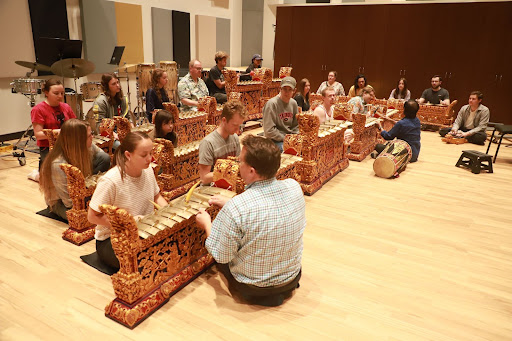This semester, BYU is offering more than 100 new classes — including a course on Balinese dance.
Professor I Gusti Agung Ayu Warsiki and her husband I Nyoman Windha are visiting this semester from Bali to teach classes about Balinese music and dance. Both professors are renowned performers in Bali, and Professor Jeremy Grimshaw invited them to BYU to teach their craft to students.
While the Balinese dance class is new this semester, a Balinese music class has been offered in previous semesters.
According to Professor Warsiki, Balinese dance is truly unique. It emphasizes intricate details and a deep connection to expression.
“Balinese dance, they have like expression, many kind of expression, depend the dance. If the dance strong, we have the strong expression and movement,” Warsiki said.
Students said even the eyes are choreographed. The slightest change in the placement of a body part can convey entirely different meanings.
Professor Windha accompanies the dancers on a traditional Balinese instrument called the “gamelan” as they practice movements during class. Students also learn to control their breath and energy, which is another important aspect of Balinese dance.
Students are learning the “Welcome Dance” and the “Margapati Dance” this semester. Janelle Wilson, a dance major taking the class, said they learn about the language and what the words mean, as well as how the two dances are different from each other.
During the Welcome Dance, the dancers use traditional Balinese fans called “sampians” to greet their audience.
Warsiki said that sampians are typically made from young coconut leaves, but in Utah it was easier to make them out of sponge material.
Wilson said the class is different from anything she has done in her life, but her favorite part of the class is her professors.
“The fact that we’re invested in each other really makes it that much more meaningful, and I love that they really care about our growth as people and as dancers,” Wilson said.
The feeling is mutual. Professor Warsiki and her husband said they are impressed with the students’ hard work. According to Warsiki, even though the dance students have never seen the movements before, when she teaches them they learn it quickly.
Windha said in both the music and dance classes he can see from students’ expressions how excited they are to learn, and they practice hard in class and at home.
Windha teaches the Balinese gamelan to a group of about 20 students. It is nice to have a big group of students for the ensemble, Windha said, as there are over 40 different types of gamelan in Bali.
Grady Grimshaw, a student in the Balinese music class, said he loves that gamelan is an instrument that must be learned face to face, as the music isn’t transcribed, which puts everyone on the same level.
“Everybody accepts that they don’t know exactly what they’re doing … And that just makes things much more, you know, comfortable,” Grimshaw said.
Additionally, it is a different experience to learn the gamelan from someone who has been practicing it their entire life. The Balinese professors bring culture to a “whole other level” than Americans can try to emulate on their own, according to Grimshaw.
“They’ve spent their whole life on it so it’s just a whole different thing,” Grimshaw said.
The gamelan class is usually taught by Professor Jeremy Grimshaw, Grady Grimshaw’s father, who was involved in starting the ensemble in 2008. Professor Grimshaw said the first piece the ensemble learned was one of Windha’s compositions.
Grimshaw met Windha through a former student, and brought Windha and Warsiki to BYU after their retirement from their positions at the national conservatory and national arts academy in Bali.
“I wanted them to come to BYU because I think it’s crucial to expose our students to different kinds of artistic expression and see the high levels of technical complexity and artistry in the performing arts of different cultures … It’s vital to give students opportunities to learn that artistry from the experts who have cultural stewardship over their traditions,” Grimshaw said.
The first time the professors came to BYU was in 2019, but their residency was cut short due to the COVID-19 pandemic.
Windha has taught gamelan at many universities and schools, but he said BYU has a special culture that he loves, which is part of why he wanted to come back this year.
“When I get here I feel something…the spirit is different, and also the city is safe and also clean,” Windha said.
Warsiki said she loves that people are so kind and friendly at BYU, and always say good morning to her. Windha and Warsiki both said they love the mountains and the public transportation in Provo. They love the spirit of BYU and relish the opportunity to share their culture with students.
Warsiki and Windha have both been practicing their respective arts since they were young. They met in high school and have been married for almost 40 years, with two children and four grandchildren together.
Professor Grimshaw said both professors are focused on their love of artistry and are highly esteemed in the world of Indonesian arts.
“They’re also very patient and thoughtful teachers as they work with those of us who didn’t grow up seeing and hearing Balinese music and dance in our communities every day. They are both incredibly kind, patient, and generous. They’re also very witty,” Grimshaw said.
Grimshaw also appreciates the connection that Windha and Warsiki have to spirituality and devotion as a part of their work, which is a part of Balinese Hinduism. Improving their skill as artists is “what we would call ‘consecrated,’” according to Grimshaw.
“I think that even though we come from different religious backgrounds, the idea that artistic work is an offering to God is really powerful and inspiring,” Grimshaw said.
Those interested in learning more can attend the upcoming concert on Nov. 4th where the Balinese music and dance classes will perform together.











